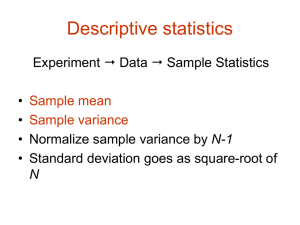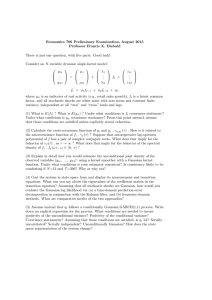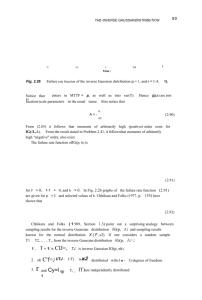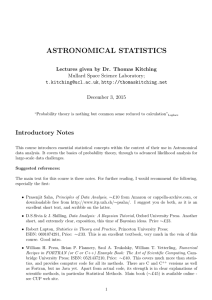Topic 3: Probability Theory and Boltzmann Distribution
advertisement
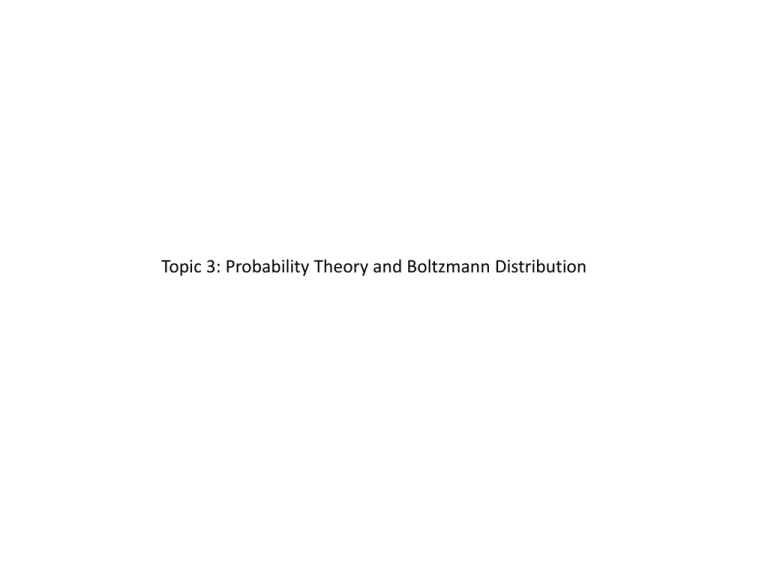
Topic 3: Probability Theory and Boltzmann Distribution The random motion of atoms: Kinetic Theory Q: What is temperature? Q: How does heat get converted into random motion? Q: If the cell is just a bunch of randomly moving molecules, how does anything useful get done? Probabilistic view of large complex systems: This room contains 1025 gas molecules – there isn’t a computer in the world large enough to track all their motion. Q: How does one make physical statements about such a large system? Ans: we describe the physical properties of large systems in terms of the statistical properties of the system (i.e averages, variances etc) This forms the branch of physics known as statistical mechanics Probability Theory: A detour Imagine there is some property of a physical system x, that you can measure. You make N measurements of x, observing the values x1 a total of N1 times, the value x2 a total of N2 times, etc. The frequency of measuring a particular value, 𝑥𝑖 𝑓𝑖 = 𝑁𝑖 𝑁 e.g. you roll a die 10 times and see the values (1, 3, 4, 4, 2, 5, 6, 1, 4) based on these measurements you would calculate that the frequencies are 𝑓1 = 2 10 , 𝑓2 = 1 10 , 𝑓3 = 1 10 , 𝑓4 = 3 , 10 𝑓5 = 1 , 10 𝑓6 = 1 10 Probability Theory: Discrete distributions If you do a large number of these measurements, N, then these frequencies converge on the true probabilities of observing that value of x. e.g. If you rolled the (fair) die many times you would find that each face occurs with the same frequency and converges to 1/6, the probability of throwing any particular face of the die. for large N, 𝑓𝑖 → 𝑃 𝑥𝑖 the probability of observing a given x Normalization: the sum of the probability of observing each outcome must add to 1 𝑃 𝑥𝑖 = 1 Probability Theory: Continuous distributions What if x takes on continuous values? how do we define a probability? We can histogram the observed values into bins of size, dx Probability Theory: Some continuous distributions x occurs uniformly over a region (e.g. 0 <= x < a ) Normal or Gaussian Distribution Q: what is the normalization constant, A? Probability theory: normalization of Gaussian, Gaussian integrals The Gaussian distribution is normalized, so 𝑃 𝑥 𝑑𝑥 = 1 Probability Theory: Mean and Variance Probability Theory: Mean and Variance Graphically Note: mean is not always the most probable value Standard deviation measures the spread of the distribution Probability Theory: Example calculation of variance Probability Theory: Summary of main results Probability Theory: Addition and multiplication rules 1) the probability that x OR y occur is P(x) + P(y) = addition rule 2) the probability that x AND y occur is P(x,y ) = P(x)P(y) if they are independent of each other == Multiplication rule e.g. roll a die and flip a coin: What is the probability that you flip x = head and roll a y = 6? P(x = head, y = 6) = P(x=head) P(y=6) = (1/2) (1/6) = 1/12 We will use these rules later when we consider the likelihood of independent events occuring

